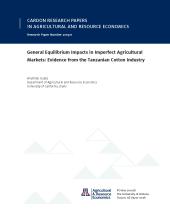General Equilibrium Impacts in Imperfect Agricultural Markets: Evidence from the Tanzanian Cotton Industry

This paper evaluates the local-economy general equilibrium effects of agricultural market structures by examining how market power of downstream intermediaries shape the economy-wide impacts of technological improvements in agriculture. Economic impact evaluations in developing countries usually do not include spillovers, and they do not explicitly consider market power. Using industry and original survey data from the Western Cotton Growing Area of Tanzania, I construct an index of oligopsony power of cotton ginners in their cotton purchase, and nonparametrically estimate the index as 0.28. The market power of downstream cotton ginners reduces cotton prices by 33-45 percent. A parametrized general equilibrium model of a cotton-producing local economy using micro-household data shows that a technological improvement in cotton production has significant spillover benefits for households not directly involved in cotton production. Intermediary market power of ginners not only mitigates the direct benefits for poor cotton-producing households but also significantly diminishes the indirect benefits for non-cottonproducing households. The direct income increases of technology improvement for the cotton producers are reduced by 2.2 to 5.6 percentage points, and the indirect income increases for the non-cotton producing households are reduced by 0.5 to 0.8 percentage points. A realistic analysis of policies aimed at raising welfare in rural economies must consider effects of market power. Taking agricultural market structure into account opens up new policy considerations and opportunities, including the benefits of laws limiting or proscribing anticompetitive behavior to prevent formation of mergers and coalitions downstream from farms.

